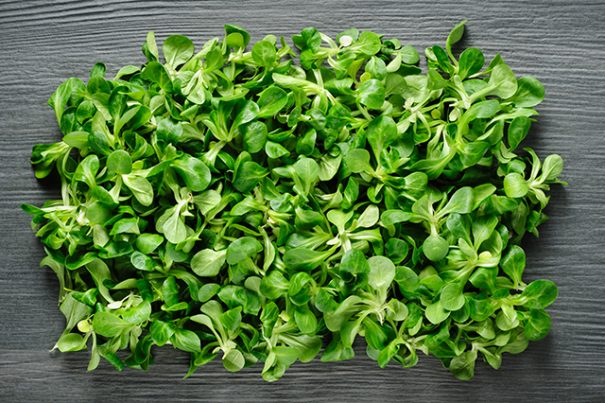- Fresh.news
- SuperFoodsnews.com
- Veggie.news
Corn Salad – sources, health benefits, nutrients, uses and constituents at NaturalPedia.com
Tuesday, August 15, 2017 by Earl Garcia
http://www.naturalpedia.com/corn-salad-sources-health-benefits-nutrients-uses-and-constituents-at-naturalpedia-com.html

Corn salad is a popular salad green commonly found in Europe, North America, and western Asia. The annual plant is characterized by its rosette shaped bunches that grow best in a mild and dry or moist soil. The leaves have a distinct sweet and nutty flavor. Corn salad comes in many names such as mache, lamb lettuce, nut lettuce, and field salad.
List of known nutrients
Like other salad greens such as lettuce and endive, corn salad is packed with essential nutrients that boost vitality and keep diseases at bay. An entry on the Nutrition Value website lists the many important components of corn salad, which include:
- Alanine
- Arginine
- Aspartic Acid
- Calcium
- Copper
- Cystine
- Glutamic Acid
- Glycine
- Histidine
- Iron
- Isoleucine
- Leucine
- Lysine
- Magnesium
- Manganese
- Methionine
- Niacin
- Pantothenic Acid
- Phenylalanine
- Phosphorus
- Potassium
- Proline
- Protein
- Pyridoxine
- Riboflavin
- Selenium
- Serine
- Sodium
- Thiamin
- Threonine
- Tryptophan
- Tyrosine
- Valine
- Vitamin A
- Vitamin C
- Zinc
Medicinal uses for corn salad
Corn salad is an excellent source of iron that promotes hemoglobin production. This is especially beneficial in preventing blood loss and anemia during menstrual cycles. Likewise, the ample iron supply in corn salad is known to stave off blood loss associated with internal and external injuries. The vegetable’s high iron levels also help prevent premature birth and low birth weight in pregnant women.
Corn salad is also notably high in vitamin A, which keeps a host of diseases at bay. According to an article on the Health Benefits Times website, the rich vitamin A content in corn salad relieves dry eyes and prevents the onset of macular degeneration. The herb is also found to reduce the risk of developing the ocular condition called Stargardt’s disease, which is brought about by the death of the photoreceptor cells in the macula.
Aside from this, the superfood’s high vitamin A levels help bolster the immune system by increasing the body’s lymphocytic responses against antigens. This, in turn, improves white blood cell function. The herb also provides the body with an extra core protection, which then counters various infections. On the other hand, the herb’s rich pyridoxine content is found to facilitate the metabolism of carbohydrates, fats, amino acids, and other vitamins.
In addition, the abundant pyridoxine supply in corn salad is touted to improve brain function and development. Previous studies have shown that the essential nutrient is needed to enhance memory and prevent the onset of various cognitive issues such as Alzheimer’s disease, dementia, and cognitive impairment. According to an AgroWeb.org entry, the pyridoxine in corn salad mitigates neural damage and regulates homocysteine levels in the body.
Moreover, the green leafy vegetable is found to prevent more serious conditions such as hypertension, osteoporosis, and diabetes. Corn salad is loaded with vitamin C that lowers blood pressure levels and reduces the odds of developing cardiovascular diseases. On the other hand, corn salad is notably high in manganese that promotes bone density and integrity. Likewise, the rich manganese supply in corn salad is found to reduce blood sugar levels in the body. The herb’s high manganese levels are also touted to reduce lipid peroxidation and promote insulin secretion and mitochondrial function.
Body systems supported by corn salad
Corn salad is especially beneficial in improving the body’s overall blood circulation and immunity. Likewise, the herb promotes heart health and prevents the onset of eye diseases. In addition, the salad green is also helpful in maintaining brain and bone health.
Ways to use corn salad
Corn salad is commonly eaten raw as a salad green. The herb goes well with other salad greens such as dandelion, mustard leaves, and frisee. Likewise, corn salad can be steamed as a hot vegetable, and may even serve as a substitute for spinach. In addition, corn salad can be lightly sauteed and added to omelets, soups, or rice. The salad green can also be cooked as a side dish, or an addition to sandwiches, stuffing, and cold pasta.
Where to learn more
Summary
Corn salad prevents anemia, heart disease, and diabetes.
Corn salad staves off eye diseases, osteoporosis, and cognitive decline.
Corn salad benefits the heart, the brain, and the bones.
Corn salad fortifies the immune system and supports eye health.
Sources include:
Tagged Under: Tags: Corn Salad







